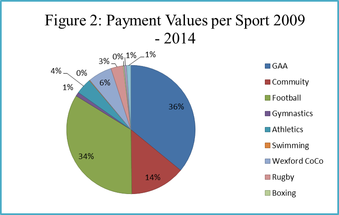In previous posts John Considine has extensively examined the allocation of the Irish Sports Capital Grant (here, here, here, here and here). This post examines the allocation, between 2009 and 2014, for one such county; Wexford.
Wexford’s sports capital payments are an example of a matching grant which is where the relevant governmental department matches funds contributed by the applicant. In this scenario of 100% of the funding, the state pays for 70%, the other 30% by the sporting institution. Wexford did not engage in any major development projects so is below the average level of payments per county from 2009 to 2014. One of the main observations found is despite the GAA receiving the highest number of payments, football associations were allocated the highest amount of funding per sport due to their ability to give more to the matching grant scheme from the profits they make.
Table 1 below provides information on the annual grant provided to the county and the annual percentage change in allocation. The striking drop in funding is explained in part by its correspondence with the Irish fiscal crisis,as the economy had contracted from $273.7bn in 2008 to $233.5bn in 2009 with a further drop to $218.4bn in 2011.
Whilst the average payment size does see a drop from 2009 to 2010, there is substantial variation over the following years showing that it is the number of payments made, and not the average payment size, which makes the most impact on the overall yearly amounts paid out. The average payment in 2012 is €41,736, relatively speaking not far from the 2009 figure of €48,554.26 however the difference of eleven payments in 2012 versus thirty-eight in 2009 explain the difference in total funding. It is apparent from the data that GAA and football clubs receive the largest grants (for the most part), due to their ability to contribute more money to the grant to be matched, and sports with lower levels of engagement (and profitability in general) such as rowing, gymnastics, swimming, and athletics receive the smallest sized grants. Figure 1 below illustrates the dominance of GAA and football in terms of the number of grants awards.
What is also evident is football clubs were in the position to contribute more to the grant scheme in this time showing that within Wexford, this is the most profitable sport.
Kathy Stout is a final year Bachelor of Arts student. She is a recipient of a University College Cork Quercus Academic Scholarships and is currently Auditor of the UCC Economics Society.



 RSS Feed
RSS Feed